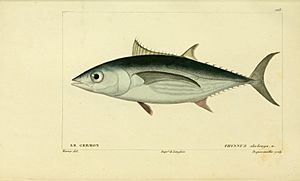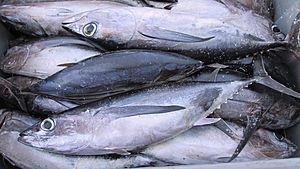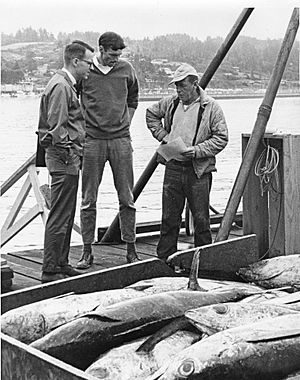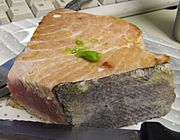Albacore facts for kids
Quick facts for kids Albacore |
|
|---|---|
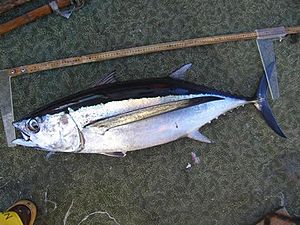 |
|
| Conservation status | |
| Scientific classification | |
| Synonyms | |
|
The albacore (Thunnus alalunga), also known as the longfin tuna, is a type of tuna. You can find it in both cool and warm waters around the world. It lives in the upper parts of the ocean, from the surface down to about 600 meters (about 2,000 feet). There are six different groups of albacore found in the Atlantic Ocean, Pacific Ocean, Indian Ocean, and the Mediterranean Sea.
Albacore have a long, torpedo-shaped body with a pointed snout, big eyes, and very long pectoral fins (the ones on their sides). Their backs are a deep blue, and their bellies are shiny silver-white. These fish can grow up to 1.4 meters (about 4.5 feet) long.
Albacore are hunters that live in the open ocean. They eat many different things, like fish, crabs and shrimp, and cephalopods (like squid and octopuses). They are special among tuna because squid are their favorite food. Albacore usually lay their eggs between November and February. A female can release over two million eggs at once! Young albacore stay near where they hatched for about a year. Albacore swim in groups, often with other types of tuna like skipjack tuna, yellowfin tuna, and bluefin tuna. Once they are grown, these groups travel long distances.
The albacore is a very important fish for fishing. People catch them for both business and fun. It was key to the tuna-canning industry in the United States. Today, it still helps the economies of many Pacific countries. The International Union for Conservation of Nature (IUCN) once listed albacore as "Near Threatened" because of too much fishing. But now, thanks to fishing rules, their numbers are recovering, and they are listed as "Least Concern."
Contents
About the Albacore Tuna
The albacore was first described by a scientist named Pierre Joseph Bonnaterre in 1788. He first put it in the mackerel family. Later, in 1983, scientists Bruce B. Collette and Cornelia E. Nauen placed it in the Thunnus group, which includes other tuna. Albacore from different oceans, like the Atlantic, Pacific, and Mediterranean, have small genetic differences.
What Albacore Look Like
The albacore has a smooth, streamlined body shaped like a torpedo. It has a pointed snout, a large mouth, and big eyes. Its back is dark blue, and its belly is silvery white. Its body is covered in small scales.
The pectoral fins are very long. They start near the first dorsal fin (on its back) and can reach past the anal fin (on its belly). These fins can be as long as 30% of the fish's total length! The top of these fins is dark blue, and the underside is a medium yellow. Younger albacore (under 0.5 meters or 1.6 feet) have shorter pectoral fins. This can sometimes make them look like young Bigeye tuna, but albacore fins come to a point, while bigeye tuna fins are rounded.
The first dorsal fin is deep yellow, and the second one is light yellow. The anal fin is also light yellow. Albacore have 7–9 small finlets behind the dorsal fins and 7–8 behind the anal fin. These finlets match the color of the body part they are on. The tail fin is silvery white.
The albacore is the smallest of the "bluefin tuna" group, reaching a maximum length of 1.4 meters (about 4.5 feet). They are ready to reproduce when they are about 0.9 meters (about 3 feet) long. Males and females look the same.
Where Albacore Live
Albacore live in tropical and temperate waters all over the world. You can find them in every ocean and also in the Mediterranean Sea. They live in waters from about 59 degrees North to 46 degrees South latitude. They prefer water temperatures between 10 and 25 degrees Celsius (50-77 degrees Fahrenheit).
They usually stay in surface waters where the temperature is between 15.6 and 19.4 degrees Celsius (60-67 degrees Fahrenheit). However, larger albacore can be found in deeper, slightly warmer waters. They can survive in water as cold as 9.5 degrees Celsius (49 degrees Fahrenheit) for short times. Albacore like areas where warm and cool waters mix.
How Albacore Travel
Albacore are fish that travel long distances. Groups of albacore move a lot, but the ones in the Atlantic Ocean don't seem to mix with the ones in the Pacific Ocean.
Every summer, North Atlantic albacore travel to the Bay of Biscay near France and Spain. They now arrive about 8 days earlier than they did 40 years ago.
Since the 1970s, scientists have been tagging albacore in the North Pacific. They've learned that young albacore (up to 2 years old) swim across the Pacific Ocean between Japan and the west coast of North America. Scientists have tagged over 24,000 albacore with small dart tags, and 1,245 of these tags have been found again.
Newer "archival tags" help scientists learn even more. These tags record daily locations, the fish's body temperature, water temperature, and depth. This helps scientists understand their movements better. Research also shows that albacore migrate between the North and South Pacific oceans, crossing the equator.
Albacore Life and Habits
The albacore is a strong and fast hunter. They often swim in mixed groups with other tuna like skipjack tuna, yellowfin tuna, and bluefin tuna. Sometimes, they gather around floating things like seaweed.
Albacore groups travel a lot and are separated by age. Older fish tend to form tighter groups. Among albacore caught by people, young ones have an equal number of males and females, but older groups are mostly male.
In the Atlantic Ocean, older albacore are found in cooler waters. But in the Pacific Ocean, they are found more often where warm and cool waters meet. The depth they swim at also changes by location. Atlantic albacore can dive as deep as 600 meters (about 2,000 feet), while Pacific albacore only go down to about 380 meters (about 1,250 feet). In the northeast Atlantic, they travel to rich feeding areas during the summer. Because of climate changes over the last 40 years, the timing and places where albacore are found have also changed.
Albacore show different behaviors depending on the region. Off Baja California, they dive deep (over 200 meters or 650 feet) during the day and stay near the surface at night. But off the coast of Washington and Oregon, they stay near the surface all day. Albacore never truly rest because they need to keep moving to get enough oxygen.
What Albacore Eat
Albacore tuna are hunters of the open sea. Their diet doesn't change much throughout the year. Unlike other tuna, like the bigeye tuna and yellowfin tuna, the albacore's main food source is cephalopods. The most common squid they eat is called Heteroteuthis dispar, a tiny deep-water squid found in the Mediterranean Sea and Atlantic Ocean. Albacore also eat fish, crustaceans, and jellyfish-like creatures. Scientists don't know a lot about their exact eating habits because albacore dive very deep (over 400 meters or 1,300 feet) to find food, and it's hard to track them there.
Albacore Life Cycle
Albacore lay eggs, which means they are oviparous. A female albacore weighing 20 kilograms (about 44 pounds) can produce between 2 to 3 million eggs each time she spawns. This usually happens between November and February. The eggs develop outside the female's body and hatch in 1–2 days. After hatching, the young fish, called fry, grow quickly. For their first year, young albacore stay close to where they hatched. They start to migrate after their first year. Albacore can live for 11–12 years, but they can start reproducing when they are about 5–6 years old.
Albacore and Humans
Commercial Fishing

Albacore is a highly valued food, and catching them for business is very important. Fishermen use different methods like pole and line, long-line fishing, and trolling.
Commercial fishing for albacore started in the early 1900s. Large groups of albacore swam near the coast of southern California, which led to the start of the fishing industry there. In 1903, an experiment with 700 cases of canned albacore was a huge success. This led to the growth of the U.S. tuna-canning industry. By the 1920s, the industry grew even more, and other tuna species like bluefin, yellowfin, and skipjack were also canned. Albacore tuna is the only species that can be sold as "white meat tuna" in cans. This label helps people know it's different from other types of canned tuna.
A study from 2010 to 2013 by Oceana, an ocean protection group, found that 84% of "white tuna" samples they tested were actually escolar, a different type of fish.
Many Pacific island countries rely heavily on tuna fishing for their economy and food. Albacore is one of the main four tuna species that support these fisheries. Fishing fleets and fish processing factories contribute a lot to the income of these countries. They also provide more than 12,000 jobs. Fish provide a large part of the protein in the diet of people in rural Pacific islands.
Fishing for Fun
Albacore are also popular with people who fish for sport. Since 2000, many people have started fishing for albacore for fun in Oregon, Washington, and California. The fishing season in Oregon and Washington usually lasts from mid-July to October.
Protecting Albacore
Fisheries Management
Albacore are managed by four main organizations that oversee tuna fishing around the world. These groups set rules and limits on how many albacore can be caught. For example, one group sets catch limits for albacore in the North and South Atlantic.
There are six main groups of albacore that are managed globally: one in the North Pacific, one in the South Pacific, one in the Indian Ocean, two in the North and South Atlantic, and one in the Mediterranean Sea.
Scientists are always working to understand how many albacore are in the ocean. While there's some uncertainty, most agree that the number of breeding albacore went down from the 1930s to the 1990s but has been recovering since then. Most studies show that albacore are not being overfished right now, but the breeding population was overfished in the past. Scientists are still learning about tuna, including how fast they grow, when they become adults, and how long they live.
The South Pacific albacore population is not considered overfished. The North Pacific albacore population also seems to be doing well and is not overfished. However, the South Pacific albacore stocks showed a 40% reduction between 2007 and 2015. Genetic research shows that while North and South Pacific albacore are separate groups, some interbreeding does happen between them.
Other Organizations
Many programs help people choose seafood that is caught responsibly and sustainably. One well-known program is the Marine Stewardship Council (MSC). Several albacore fisheries have been certified as sustainable by MSC. This includes the U.S. North and South Pacific pole and line and trolling fisheries, the Canadian North Pacific trolling fishery, and the New Zealand South Pacific trolling fishery.
Another group, SeaChoice, rates albacore as a "best choice" for consumers. However, they note some concerns about how well the fisheries are managed, especially because there isn't a clear assessment of the Indian Ocean albacore stock. They also have some concerns about the North Atlantic albacore population, which some consider overfished.
Mercury Levels in Albacore
Like other fish, albacore can collect a substance called methylmercury in their bodies over time. The human body can remove methylmercury naturally, but it takes a long time.
The amount of mercury in albacore can vary, but on average, it's about 0.14 parts per million (ppm). Larger fish tend to have higher mercury levels. Albacore caught off the coasts of Washington, Oregon, and California have much lower mercury levels than in past years. These levels are also well below the 1.0 ppm mercury standard set by the U.S. Food and Drug Administration (FDA). Still, because mercury stays in the body for a while, it's a good idea to eat albacore tuna in moderation.
Albacore in the Kitchen
Albacore meat is very versatile and used in many different dishes, just like other types of tuna.
- Albacore cuisine
-
Lightly cooked albacore steak -
Seared albacore in a salade niçoise -
Bonito del Norte con piperrada, a Basque dish using albacore
Other Species Called Albacore
Sometimes, other fish are also called "albacore" in different parts of the world:
- Blackfin tuna (sometimes called albacore)
- Yellowfin tuna (sometimes called albacore, autumn albacore, or yellowfinned albacore)
- Yellowtail amberjack (sometimes called albacore)
- Kawakawa (sometimes called false albacore)
- Little tunny (sometimes called false albacore)
See also
 In Spanish: Atún aleta larga para niños
In Spanish: Atún aleta larga para niños



